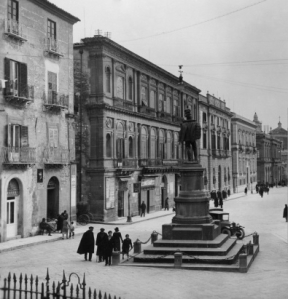
When I was young, my brothers, sisters and I were often relegated to the basement, mostly to keep out of my mom’s way while she was cleaning and cooking. But we didn’t mind. The basement was cool in the summers before we had central air conditioning. It was full of old books, old records and old photo albums. I loved looking at the old pictures, carefully arranged on the black sheets. At first, I was only interested in seeing pictures of me and my siblings growing up, but later I started prowling among the older photo albums, amazed at seeing my mother as a child and teenager. One photo in particular stood out. It was a large picture. There were about thirty people arranged outside a house. The mothers held babies in their laps and the fathers wore white shirts and ties. In the middle of the photo sat a stout, old woman, her white hair pulled back into a bun. She wore a black dress and although many in the photo were smiling, she was not. To me, she looked like Queen Victoria of England. I carefully carried the album upstairs and asked my mother who the woman was. “That’s my Grandma,” my mom told me. She laughed, looking at the photo “My brothers and I used to joke that she was as wide as she was tall.”
Maria Francesca Muglia was born on November 22, 1866 in a tiny town in southern Italy called Guardia Piemontese. The town is located in the mountainous region of western Calabria, on the Tyrrhenian Sea. The people speak a peculiar dialect called Occitan, which originated in Southern France and was brought to Guardia Piemontese with refugees from Northern Italy who were escaping persecution from the Catholic Church.
Maria Francesca stood only 4 foot 8 inches tall. She married Francesco Pepe on August 5th, 1886, when she was 20 years old and he was 27. Francesco was also born and raised in Guardia Piemontese and the two families were most likely piesans, or close friends. On the marriage certificate, Francesco’s occupation was listed as contadino, or peasant. He was most likely a worker on a farm. Maria Francesca’s occupation was listed as filatrice, or spinner. Her father was deceased by the time she married, so perhaps she had a job to help support her family.
A year later, the couple had a son, whom they named Luigi after the paternal grandfather, as was the custom. Luigi was followed two years later by Maria, then Giuseppe, born in 1892 and named after the maternal grandfather. Tragically, Maria Francesca lost her daughter when little Maria died when she was only four years old. Maria Francesca was pregnant with son Domenico at the time. Tragedy struck again as Domenico died at the age of fifteen months. Her heart must have broken in two when baby Carmela, born in 1898 died after only eight months.
Around this time, the couple decided to leave Italy behind and start a new life in America. Francesco saved up enough money for him and oldest son Luigi to travel to New York. In March of 1901, they arrived in New York and went to stay with relatives in Bellington, West Virginia. Remaining in Italy, Maria Francesca was five months pregnant and had a young son to care for. Did she stay with relatives or go back to being a spinner to support her family? How did she send word to the United States that a son named Domenic was born in July? How long would a letter take to cross the ocean?
Maria Francesca and Francesco spent two years apart as he struggled to establish a new life and earn enough money to send for his family. By 1903, Francesco and Luigi had moved to Philadelphia, New York, where Frank Pepe, as he was now known, worked for the railroad. Maria Francesca traveled 300 km to Naples and left on the S.S. Umbria on May 27, 1903 and arrived in New York on June 10. She traveled with her sons Giuseppe and Domenic, aged 11 and 2. It is interesting to note that she traveled under her maiden name, and is listed on the ship’s manifest as Maria Francesca Muglia. The boys are mistakenly listed with the last name of Muglia instead of Pepe. However, once in the United States, she became Mary Frances Pepe. Luigi’s and Giuseppe’s names also were Americanized to Louie and Joe.
The next years must have been happy ones as the family was reunited. The family grew with the births of Grace, Gus and Rose over the next four years. But the happiness was not to last. Frank contracted pneumonia and died on October 15, 1907, leaving Mary Frances widowed with six children to care for. The baby, Rose, was just seven months old. Mary Frances wanted to return to Italy, but her older sons convinced her to stay, reminding her how hard life had been in Guardia Piemontese. Louie married in 1910, and moved with his new wife to a house down the street. Mary Frances continued to live with the remaining five children in Philadelphia. Around 1923, Mary Frances and her children moved seventeen miles south to Watertown, New York, probably to live with one of the older sons. Louie, Joseph, Domenic and Gus all moved to Watertown and all worked as buffers in a brass plant. In 1932, when the picture I had dug from the basement was taken, Mary Frances lived with her son Gus and his family.
She died ten years after the picture was taken, survived by her six children and 34 grandchildren. Mary Frances was a feisty, resilient woman, who, even when faced with extreme difficulties, taught her children the importance of family.
 (Picture of Mary Francis Pepe surrounded by her children, their spouses and grandchildren. My mom is being held by her father – third man from the right in the last row)
(Picture of Mary Francis Pepe surrounded by her children, their spouses and grandchildren. My mom is being held by her father – third man from the right in the last row)
Posted in
family,
family history,
family photos,
family tree,
genealogy,
Italian genealogy,
life and tagged
#familyhistory,
#italian,
#Italiangenealogy,
#memories,
52 Ancestors Challenge 2015,
52 Ancestors in 52 Weeks,
family tree,
genealogy
 Concetta Abbate was born May 2, 1858 in Villarosa, Sicily, Italy to Ignazio Abbate and Rose Vitale. She married Angelo Fiandaca on September 8, 1881 when she was 23 years old. Angelo was 33 and a widower with at least two children. Concetta and Angelo had three children – Ignacio born in 1888, Guiseppe born in 1890 and Rose born in 1893. Angelo died on April 17, 1910 in Villarosa.
Concetta Abbate was born May 2, 1858 in Villarosa, Sicily, Italy to Ignazio Abbate and Rose Vitale. She married Angelo Fiandaca on September 8, 1881 when she was 23 years old. Angelo was 33 and a widower with at least two children. Concetta and Angelo had three children – Ignacio born in 1888, Guiseppe born in 1890 and Rose born in 1893. Angelo died on April 17, 1910 in Villarosa.









You must be logged in to post a comment.